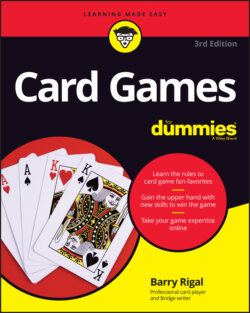Читать книгу Card Games For Dummies - Barry Rigal - Страница 61
Cheat
ОглавлениеChildren love Cheat (which is also called I Doubt It) because it gives them the opportunity to develop their deceptive powers in a way that their parents approve of. Most children master the art of lying convincingly and looking guilty when telling the truth very early on.
You need the following to play Cheat:
Three or more players: You can play with up to 12.
A standard deck of 52 cards: You normally play Cheat with a single deck of cards for up to five players. With 6 to 12 players, use two decks.
The object of Cheat is to get rid of all your cards as quickly as possible. To do that, you play your cards face-down, announcing what you put down — but you don’t have to tell the truth.
The dealer deals out all the cards one at a time, face-down and clockwise, and the players pick up and look at their cards. The player to the left of the dealer is first to play.
The first player puts down cards onto a central pile on the table, squaring the cards up so that other players can’t see precisely how many cards they have put down. They then make an announcement about their play, along the line of “three 6s” or whatever they consider appropriate. The statement can be false in more than one way. They may put down more or fewer cards than they claim, or they may put down cards unrelated to what they claim. The players who follow put their cards on top of theirs.
Some people require that the play must consist of the correct number of cards, whether or not they are what you claim them to be.
If no player challenges the claim (and anyone can do so), the turn moves clockwise to the next player. The next player also makes a play face-down, and they have three choices:
To make a challenge, someone calls out “Cheat,” and the player accused has two options:
They can concede (gracefully or otherwise) by picking up the entire pile.
They can turn over the cards they just put down to demonstrate that they were telling the truth, in which case the challenger must pick up the whole pile.
The player who picks up the pile from the center gets to start the next round with whatever number they want.
If you have a dispute over who called out “Cheat” first, the player nearest to the left of the accused has priority.
If no one has called “Cheat,” then the next player has to pick up from the last set put down. They have three choices as to what to play.
They can claim to be playing the same rank as the previous player: If the first player claims to lay three 6s, the next player can take this choice by putting down a number of 6s.
They can claim to be playing cards of one rank higher: If the first player claims to put down 6s, “cards of one rank higher” means as many 7s as they want.
They can claim to be playing cards of one rank lower than the previous move: If the first player claims 6s, any number of 5s works for the next player.
The second player can’t pass. They put their cards face-down on the table, on top of the previous play. Of course, they may be lying!
The next player has exactly the same set of options (play the same rank as the previous player or one higher or one lower), and play continues until someone makes a challenge.
The winner of the game is the person who succeeds in playing all their cards first. A player can go out by withstanding a challenge on their final turn or by going unchallenged before the next player makes a play. In practice, someone always challenges a player going out, but if you can conceal that you have no cards left on your last play (not easy to do!), you may avoid a challenge.
Some people play that the second player’s turn is far less flexible. If the first player plays 6s, the next player must play 7s, and the one after that must play 8s. This variation takes away some of the flexibility in the play, but it makes it much easier for younger children to determine what they should do. Because only one play is possible, everyone knows what comes next.
